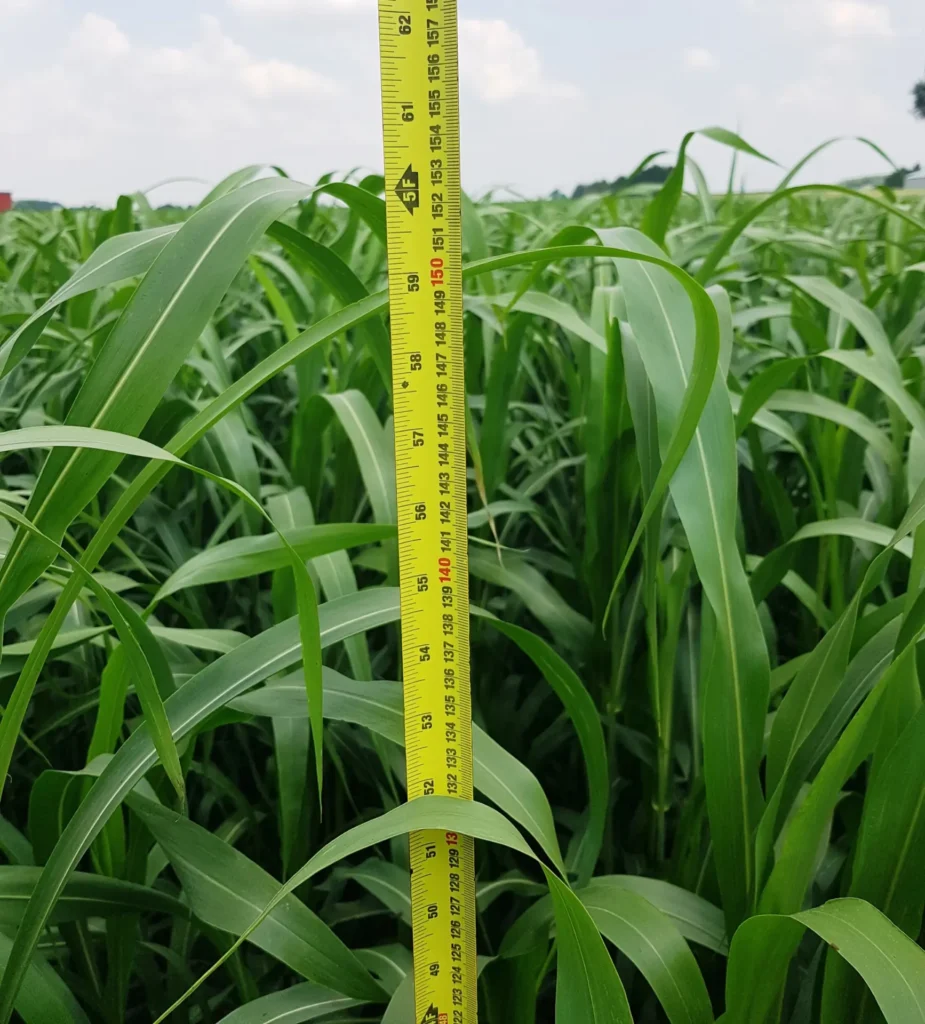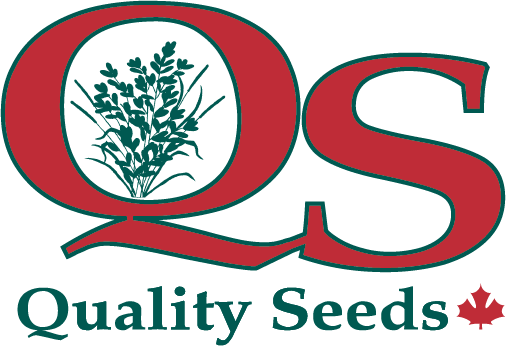Sudangrass & Sorghum-Sudangrass For Extra Forage

Sudangrass and sorghum-sudangrass are warm-season annual grasses from the sorghum family. They are grown in the summer and have the potential to provide high yields of palatable, high quality forage when managed properly. Although rainfall is necessary for optimal growth, they are very drought tolerant and respond well to hot summer weather. They are very frost sensitive, both in the spring as seedlings, as well as in the fall when frost will kill them, preventing any further growth.
Consider terminating winter injured, low yielding alfalfa fields after first-cut and planting to sorghum-sudangrass or sudangrass for emergency forage. They can also be planted into unseeded soybean and corn acres during a wet year to provide additional forage.
While sorghum-sudangrass has higher yield potential, sudangrass is leafier with much finer stems, which provides higher forage quality. New BMR (brown mid-rib) types of both species are available, which provide low-lignin, higher fibre digestibility (NDFD) for improved forage quality. Yield expectations under optimal weather conditions, management, and timely seeding are 3 – 4 tonnes or more of dry matter per acre. Harvested at the correct stage with good fertility, these crops, particularly BMR types, have high digestible energy and crude protein levels of 15 – 20%. For dairy quality feed, BMR sudangrass is preferred. The BMR sudangrass varieties exclusive to Quality Seeds include SS2.
Seeding
Sudangrass and sorghum-sudangrass require a soil temperature of at least 15.5 – 18°C (60 – 65°F) for optimal germination, rapid emergence and growth. This typically occurs the last week of may or early-June. They do not perform well in cold soils. While they have very good drought tolerance once established, some rainfall is necessary for germination and early growth.
Sudangrass and sorghum-sudangrass can be no-till drilled following a low yielding alfalfa stand after first-cut and a burndown, or seeded into a prepared seedbed. Sorghum-sudangrass and sudangrass seedlings are not competitive in an existing alfalfa-grass stand, so a burndown or tillage is necessary. No-tilling into an existing stand without a burndown or tillage is usually disappointing. An application of glyphosate, or a “stale seedbed” system (tillage followed by harrowing after weed seedlings emerge) before seeding should be done to prevent excessive weed competition (particularly grasses) to sorghum seedlings. When following an unproductive first-cut, a pre-harvest application of glyphosate can enable an earlier seeding.
Proper seeding depth and seed-to-soil contact is important. Suggested seeding depth for sudangrass is ½ – ¾ inch and ¾ – 1 inch for sorghum-sudangrass. The seedbed should be firm, and well packed after seeding. Seeds planted too deep, or too shallow by broadcasting, frequently result in seeding failures. A no-till drill is best for proper seed placement. A suggested seeding rate for sudangrass is 25 – 30 lbs/ac. A suggested seeding rate for sorghum-sudangrass is sometimes 40 – 50 lbs/ac, but a seeding rate of up to 60 lb/acre can provide a stem that is finer and less coarse, and also provides greater competition against weeds.
Fertility
Nitrogen (N) is essential for high yield and protein content. A split application of nitrogen should be applied at seeding at a rate of 80 – 90 lbs/acre of actual N (185 lbs urea), and an additional 50 – 60 lb/acre (120 lbs urea) after each cut for the next cutting, depending on yield potential. (50 lbs/acre of actual N for each tonne of expected dry matter yield.) If liquid manure is to be applied, it should preferably be done before planting, or immediately after harvest (within 2 days) and N rates should be adjusted accordingly. There is some susceptibility to heavy traffic damage. P and K removal rates are similar to other grass forage species – approximately 12 lbs P2O5and 50 lbs K2O per ton of dry matter yield.
Weed Control
Growth of these species is initially modest, but accelerates very rapidly at about the 7 – 8 leaf stage. Once established at this stage, rapid growth usually out-competes most weeds, and herbicide weed control is not necessary. However, if broadleaf weed pressure is heavy at the seedling stage, herbicide application may be considered. Refer to OMAFRA Publication 75, Guide To Weed Control www.omafra.gov.on.ca/english/crops/pub75/pub75A/pub75A.pdf,
p.186. Herbicides include bromoxynil (Pardner) and prosulfuron (Peak + Assist).
Growth & Harvest
After seeding, seedlings should emerge within a week given warm soils and adequate moisture. Dry weather can delay emergence.
For dairy cow, high quality feed, first-cut typically occurs 40 – 50 days after planting, before the “head emergence” stage, while the crop is 36 – 45 inches in height. Nutrient quality drops quickly and dramatically at heading. A rule-of-thumb is 45 days or 45 inches, whichever comes first. Regrowth is rapid, and a second-cut is usually ready 30 – 35 days later.
These species are harvested as haylage or baleage, but because their stems contain high moisture levels, they cannot be dried for hay. A high cutting height of at least 4 inches (leaving 2 growth nodes) is required for faster regrowth. Wide swaths and proper roll conditioning (crimping) enables faster wilting to proper ensiling moisture. Adequate packing for efficient fermentation can sometimes be an issue with coarser stemmed sorghum-sudangrass.
While 2 cuts are common, with timely seeding and aggressive cutting schedules, and without an early frost, 3 cuttings in a season are possible.
Nitrates & Prussic Acid
Ideally, the final cut of the season should be taken before frost to optimize forage quality and eliminate potential prussic acid risk and high nitrates. Prussic acid toxicity after frost can be a potential issue with sorghums when grazed, but this is usually not an issue as haylage when fully fermented.
Nitrate toxicity is possible with warm-season annual grasses, particularly if harvested following a drought-ending rain, but again, this is also more of an issue with pasture and green-chop. When high nitrates occur, fermentation dissipates the nitrates as nitrogen dioxide (silo gas).
For information on how to manage to risk of prussic acid and nitrate poisoning, particularly in green chop and pasture situations, refer to “Forage Sorghum-Sudangrass” at www.omafra.gov.on.ca/english/crops/facts/98-043.htm.
Using BMR Sudangrass As A Companion Crop With Forage Underseedings
This has been done successfully by farmers in Quebec and on a smaller scale by farmers in Ontario using specific management practises. Quality Seeds did some plot trials in 2019 under Ontario environmental conditions with very promising results. (Figure 3)
Additional suggested management practises to consider when underseeding to BMR sudangrass are as follows:
- Glyphosate burndown and tillage before planting essential
- 20 lbs/ac sudangrass and 18-20 lbs/ac alfalfa-grass blended together, seeded with a no-till drill through the cereal box at ½ inch seeding depth (maximum), seedbed well packed and firm
- Nitrogen fertility requirements are the same as above
- Do not apply manure after planting or harvest – very susceptible to traffic damage
- Harvest the last cut before September or just before frost, avoiding the critical fall harvest period


Figure 1 – HayKing II BMR sudangrass planted at 35 lbs/ac on June 18th. Pictured at 40 days. Elmira area.


Figure 2 – HayKing II BMR sudangrass planted May 28th, Listowel area. Pictured at 50 days.


Figure 3 – Same field as Figure 2, showing underseeded alfalfa-grass


Figure 4 – HayKing II BMR sudangrass 45 days after planting. Summitholm Holsteins, Ancaster. July 31st.


Figure 5 – SS2 BMR sudangrass planted July 9th, harvested August 22nd, Cannington.


Figure 6 – SS2 BMR sudangrass planted July 25th, harvested September 13th. Prince Edward County.
